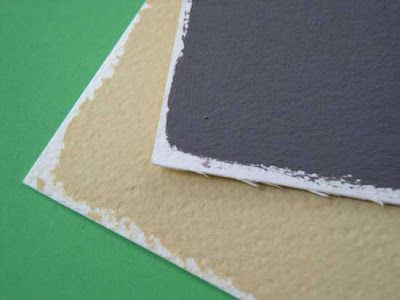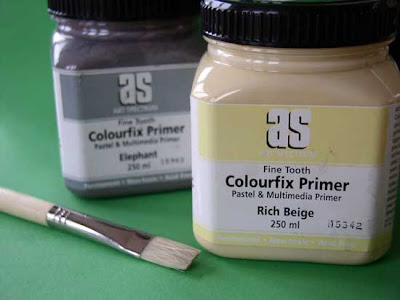The advantages of preparing your own surface with the primer over buying the Colourfix paper are that:
- I can use various surfaces. For instance, for my pastel Summer Walk, I used a textured Fabiano watercolour paper. The primer made it suitable for pastel, while the grain of the paper created an effect close to oil painting on a coarse canvas.
- When you buy the readymade Colourfix paper, it comes with a white margin. Unless you use the whole sheet of paper, you are going to waste some paper. With the primer, you cut your surface to size first and prepare it, so you can leave the margin you want on the format you want. This gives more flexibility and no waste.

This acrylic primer is lightfast, acid-free and give to the surface a fine tooth. So, provided you use an archival surface (like a cotton rag based watercolour paper), your support will have archival qualities.
The primer is quick drying. For best results, you need to apply two coats. Two thin coats are better than one thick coat. I used a household paint brush to do the job. It was easy and quick. As it is an acrylic primer, you clean your brush with water. Make sure you clean your brush immediately; otherwise, you will have a hard time to get it back in shape. You can also apply the primer with a sponge or a roller if you want to create some texture.
Regarding the type of surfaces the primer can be applied to, the possibilities are wide: paper (preferably heavy paper 300lb or more), canvas, card, plastic, ply, timber, masonry, terracotta (bisque fired) pots, ceramic, metal and glass. Ensure the surface is clean and dry.

20 colours are available in 250ml pots (Rich Beige, Sand, Soft Umber, Storm Blue, Aubergine, Blue Haze, Burgundy, Fresh Grey, Leaf Green Dark, Rose Grey, Deep Black, Elephant, Deep Ultra Blue, Terracotta, Burnt Umber, White, Clear). All colours can be intermixed, or tinted with ink, gouache or acrylic.
One use I have not tried yet if for collages. The manufacturer advertises the “strong bonding qualities” of the Colourfix Primer that can be used as a good adhesive for all types of materials. According to Art Spectrum, “cloth, canvas, paper, rubber, plastic and other objects can be embedded in a wet coat of Colourfix. Individual items can be coated and glued onto papers, cardboard, plywood or other similar porous surfaces.” This could be really interesting for mixed media project or to pre-texture a surface with paper coated with the primer and then stuck onto a board or a canvas.
The primer, once dry, is waterproof. Pastel underpainting with pastel washed with alcohol or oil paint underpainting works well. By contrast, watercolour did not work well as the surface would not absorb the water. This is the only limitation I have found to using this product so far.
A one page document titled “Techniques for Removing Pastel from Art Spectrum Colourfix Papers” explains all the techniques that can be used. The most important point is that the surface will take repeated erasure, so most techniques will work.
Art Spectrum Colourfix Paper Art material Pastel Pastel surface

No comments:
Post a Comment